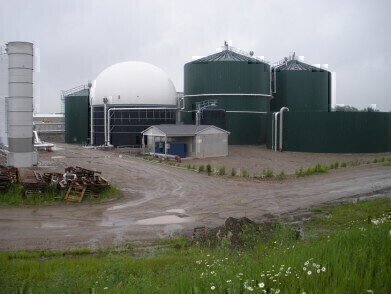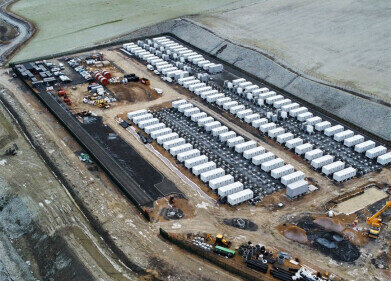Green Energy
Organic Waste-to-Energy Project Illustrates Global Potential of Biogas to Provide Green Power
Apr 15 2014
An organic-waste-to-energy project in a city the size of Canberra, the Sunshine Coast or Newcastle is set to demonstrate benefits achievable worldwide by converting more than 65,000 tons of mixed organic waste a year into environmentally harmonious green energy and dry fertiliser.
The city of London, Ontario, Canada, with population about 366,000, will this year see the launch of the privately owned Harvest Power Mustang Generation Limited plant that will process more than 15 different waste streams into biogas to generate electricity as well as dry bio fertilisers.
The 4.5 hectare plant – incorporating a Global Water Engineering (GWE) RAPTOR™ system engineered by GWE – harvests waste such as grocery store rejects, kitchen and market waste, food processing residues, leachate, manure, and slaughterhouse residues, which it converts into enough biogas primarily (methane) to generate 2.85 MW of electricity and 8.7 tons a day of dry bio fertiliser.
The GWE technology involved is represented in Australia by CST Wastewater Solutions, whose Managing Director, Mr Michael Bambridge, says such green energy/environmental initiatives are readily adaptable to a host of Australian cities.
“This organic waste-to-energy project is just a further step along a path that already has globally proven benefits,” he said.
Biogas replaces fossil fuels typically used to heat factory process plant such as boilers or to generate electricity. The London Ontario plant’s biogas production of more than 27,000 Nm3 a day @62.5 per cent methane (CH4 ) is equivalent to 20,000kg a day of fuel oil, or 7,300 tons of the fossil fuel a year, worth nearly $US 6 million (SA more than $6.5 million) a year* while cleaning up the environment.
Industrial waste water plants equipped with similar RAPTOR technology have already achieved production rates of twice as much green energy a year, so Harvest Power’s targets are eminently realistic and easily expanded on a global scale, says the President and CEO of Global Water Engineering, Mr Jean Pierre Ombregt, who has been a world leader in anaerobic digestion of industrial effluents and green energy solutions for more than 35 years.
GWE’s RAPTOR™ (which stands for Rapid Transformation of Organic Residues) is a powerful liquid-state anaerobic digestion process that consists of enhanced pre-treatment followed by multi-step biological fermentation. In the Harvest Power application, it is integrated into a process that begins with waste reception and storage, depackaging and conditioning, and the removal of contamination such as plastics, metals, and glass. It then undergoes thermophilic acidification, anaerobic digestion by the RAPTOR™ process, post digestion, aerobic treatment of the liquid part of the digestate, sludge conditioning and drying. This is followed by biogas sweetening (removal of hydrogen sulfide), drying and then use in combined heat and power (CHP) systems and engine generator sets of 2.85 MWe feeding back into the local electricity grid.
The RAPTOR™ process consumes most (76 per cent) of the potentially environmentally harmful COD (chemical oxygen demand) content of the waste, which comprises content of natural origin that can be broken down into biogas by anaerobic bacteria.
While the biogas is conditioned and utilised to produce energy, solids and liquid residuals provide valuable fertiliser products.
The plant is significant globally because of the range of waste feedstocks it converts into useful products: Market waste ; kitchen waste; grease trap waste; dewater DAF flotation residue ; paunch manure; pet food; ice-cream waste ; food processing wastes ; expired beer ; and many other community sources.
The odour-free, rapid throughput design attracted the strong community backing essential to its success.
Jean-Pierre Ombregt says the type of anaerobic technologies being employed at the Harvest Power site can pay for themselves in a year or two through savings in fossil fuel, while also protecting the environment from groundwater and air pollution.
“Other green energy sources such as solar and wind power get the headlines, but waste product/green energy technologies such as those from GWE deliver the results in terms of base load and cost-efficiency.
“This type of plant can be replicated anywhere there is a community, factory or process with one or more digestible solid waste streams. Such plants – including breweries, fruit, food waste, agro industries, and energy crops including corn – can easily use this technology to generate energy. It opens the door to environmental and production efficiency gains globally,” says Mr Ombregt, whose company has been involved in more than 300 water, waste water and green energy projects in 70 counties in regions including Africa, North and South America, Australia, China, Europe (including Eastern Europe), Russia and South-East Asia.
In the RAPTORTM process, the pre-treated and blended substrate slurry is transferred into one or more completely mixed digesters that use energy efficient and low maintenance mechanical mixing. The digester tanks come in sizes up to 12,000 m3. Optional extras include a heating system, a scum control system and a bottom grit trap.
The digester tank is fully insulated and can be heated by recycling the digester contents through a special heat exchanger.
Loading rates of up to 10-15 kg COD/m3 per day, and biogas production rates of up to 6.3 Nm3 per digester per day, can be obtained in RAPTOR plants, depending on the nature of the substrate.
The digestate from the digester is usually treated in a centrifuge for removal and disposal of non-digestible solids in the form of wet sludge cake, ideal for use as an agricultural fertiliser. Sludge cake drying and pelletising systems are also available.
The liquid concentrate from the digester is added to the fresh solid waste in the slurry-making stage, or recycled to the first stage of treatment, or ultimately disposed of in a conventional aerobic wastewater treatment plant.
Events
Apr 22 2024 Hannover, Germany
Apr 23 2024 Kuala Lumpur, Malaysia
Apr 24 2024 Sao Paulo, Brasil
May 05 2024 Seville, Spain
May 13 2024 Munich, Germany














